The Noldor II (from the Dagor-nuin-Giliath to the Dagor Bragollach)
After Fëanor and his host landed in Middle-earth, they travelled up the Firth of Drengist into Hithlum. There they came across Lake Mithrim, and made their camp upon its northern shore. But the hosts of Morgoth were aroused by the noise and the light created by their arrival, and they swooped down on Mithrim in a surprise attack. Thus started the Dagor-nuin-Giliath – Battle-under-Stars. Morgoth’s hordes were routed, and in a wild and fey mood, Fëanor followed Morgoth northwards, wanting to battle the Vala.
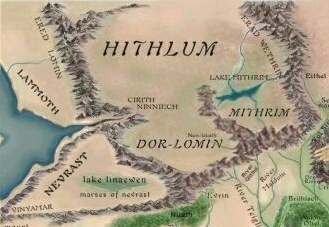
“he laughed as he wielded his sword, rejoicing that he had dared the wrath of the Valar and the evils of the road, that he might see the hour of his vengeance.” (Silmarillion, Of the Return of the Noldor)
On seeing Fëanor draw ahead of his people, the forces of Morgoth turned back to face him, and Balrogs issued from Angband to aid them. The elf was there mortally wounded by Gothmog, and was carried from the field of battle by his sons. He died soon after on the slopes of the Ered Wethrin, looking over towards Thangorodrim.
After Fëanor’s death, Morgoth send out an embassy to his sons, acknowledging defeat and offering terms – even to the surrender of a Silmaril. Maedhros persuaded his brothers to pretend to be interested in pursuing the surrender. Both parties turned up to the parley with great armies, though Morgoth’s hosts were larger, and Maedhros was taken captive.
The Noldor then withdrew to Mithrim, and set about fortifying their camp. Morgoth sent word to them than Maedhros was to be kept as a hostage until the Noldor forsook their war and their vendetta, returning to the West or departing Beleriand to live in the south of the world. This, of course, the sons of Fëanor could not do, being constrained by their Oath, and not believing that Morgoth would free Maedhros under any of his conditions. When Morgoth
heard of this, he took Maedhros and hung him by the wrist from the face of a precipice
upon Thangorodrim.
The effects of the Oath
In biding their time, the Sons of Fëanor were not contravening their Oath in any way:
“[they] did not purpose to seek the Silmarils by craft or war, or to suffer any others to do so, until they had all the might of the Elf-kingdoms under their hands.” (Silmarillion, Of Beren and Lúthien)
It thus seems that the Oath gave them some latitude, in that they could play a waiting game and choose which strategy they wanted to gain the Silmarils (i.e. gain direct control over all the Noldor and Sindar in Beleriand first), rather than being compelled to attack Morgoth at every opportunity.
Fingolfin’s entrance to Middle-earth
Fingolfin’s host eventually arrived in Middle-earth, over 20 years behind Fëanor, just as the Sun was arising for the first time.
Tolkien’s description of this second Noldor host in Middle-earth clearly shows his intention for Fingolfin’s people to be the opposite of Fëanor’s people – the light to Fëanor’s dark, the calmness to his chaos.
“Fingolfin unfurled his blue and silver banners, and blew his horns, and flowers sprang beneath his marching feet, and the ages of the stars were ended. At the uprising of the great light the servants of Morgoth fled into Angband, and Fingolfin passed unopposed through the fastness of Dor Daedeloth while his foes hid beneath the earth.” (Silmarillion, Of the Return of the Noldor)
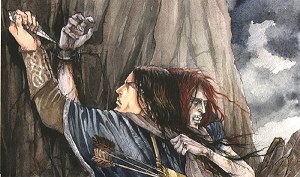
Fingolfin’s people also camped out by Lake Mithrim, on the other side of the lake from Fëanor’s clan. By then, many of the first host of the Noldor had repented of the ship-burning at Losgar, and would have welcomed the new arrivals, but dared not, for shame.
However, the rift between the Houses soon started to be healed when Fingon, son of Fingolfin, sought out Maedhros, son of Fëanor. The two had been friends in the Blessed Realm and Fingon realised that the two hosts should be reconciled before Morgoth could set forth again from Angband.
How Fingon discovered that Morgoth held Maedhros at Angband is unknown, but eventually he managed to find his friend on the slopes of Thangorodrim. He sent up a plea to Manwë, and Thorondor appeared and took Fingon up to Maedhros, where he had to cut off his friend’s wrist to free him from Morgoth’s band of steel. The eagle then took them both back to Mithrim. Maedhros slowly healed from his terrible injury, for the fire of life was bright within him, and his strength was great – as was that of all those who grew up in Valinor. He eventually learnt to wield his sword with his left hand even more deadly than with his right, but his soul remained scarred.
Maedhros later begged forgiveness from Fingolfin for Fëanor’s desertion in Araman, and he ceded the kingship of the Noldor to Fingolfin – making the House of Fëanor dispossessed, as predicted in the Doom of the Noldor. However, not all of his brothers thought that action wise.
Meeting the neighbours
The Noldor soon started to spread out over Middle-earth, and each of the sons of Fëanor created their own territories, as did Fingolfin and the sons of Fingolfin and Finarfin. They also started encountering the Grey-elves of Beleriand and the Sindarin elves of Doriath.
Doriath
Thingol refused to open his kingdom to the Noldorin princes, nor remove its Girdle of Enchantment, for Melian had advised him that Morgoth’s restraint would not last. Only those of the House of Finarfin were allowed into Doriath, for through their mother they had kingship with Thingol. Angrod was the first of the Noldor to be allowed into Menegroth, and he spoke long with Thingol, telling the King of the deeds of the Noldor and their numbers in Middle-earth. However, he spoke no word of the Kinslaying or the Oath of Fëanor, and when he finished, Thingol gave him leave to tell the Noldor that they were given leave to live in Hithlum, Dorthonion and the empty lands east of Doriath. But he also made it clear to Angrod that he was the King of Beleriand:
“Beware therefore how you princes of the West bear yourselves; for I am the Lord of Beleriand, and all who seek to dwell there shall hear my word. Into Doriath none shall come to abide but only such as I call as guests, or who seek me in great need.” (Silmarillion, Of the Return of the Noldor)
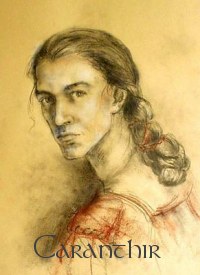
When Angrod returned and told the message from Doriath to the lords of the Noldor, Caranthir became angry at their cavalier treatment by Thingol:
“Yea more! Let not the sons of Finarfin run hither and thither with their tales to this Dark Elf in his caves! Who made them our spokesmen to deal with him? And though they be come indeed to Beleriand, let them not so swiftly forget that their father is a lord of the Noldor, though their mother be of other kin.” (Silmarillion, Of the Return of the Noldor)
While Maedhros rebuked Caranthir, most of the Noldor became troubled, wondering if the fell spirit of the sons of Fëanor would burst out once more into rash word or violence.
Soon after, however, the sons of Fëanor left Mithrim, and travelled to the lands around the Hill of Himring. That region, open to the lands of Angband to the north, became known as the March of Maedhros, and there Maedhros and his brothers kept watch over Angband. It was said that Maedhros deliberately chose those lands as they would be the first line of defence against Morgoth.
The Naugrim
The people of Caranthir lived the furthest east of all the sons of Fëanor, dwelling about Lake Helevorn under Mount Rerir. While exploring the Ered Luin, they came across the Dwarves of Nogrod and Belegost. Though neither people came to have great love for each other, they made an alliance against Morgoth, their common enemy.
“the Dwarves were secret and quick to resentment, and Caranthir was haughty and scarce concealed his scorn for the unloveliness of the Naugrim. And his people followed their lord.” (Silmarillion, Of the Return of the Noldor)”
The alliance was of great profit to Caranthir, as when the Dwarves restarted their trading with Beleriand, all goods came through Caranthir’s hands.
Fingolfin – High King of the Noldor
“Therefore when the council came to the choosing of one to be overlord of the Exiles and the head of all their princes, the choice of all save few fell on Fingolfin” (The Grey Annals).
Fingolfin became the first High King of the Noldor in Exile, and managed to keep his kingdom and his people well-cared for, safe, and secure for many years, right up until the Dagor Bragollach.
Mereth Aderthad
Twenty years into his reign, Fingolfin held a great feast in the spring near to the pools of Ivrin. It was known as the Mereth Aderthad, the Feast of Reuniting, and provided a golden memory in the days of shadow that were to come.
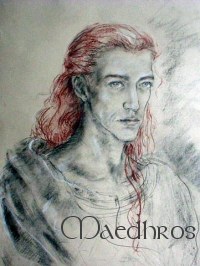
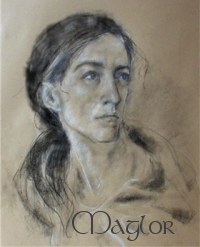
Many came from all over Beleriand, including:
– Maedhros and Maglor with warriors from the March
– Many of the chieftains and people of Fingolfin and Finrod
– Great numbers of grey-elves from Beleriand
– Círdan and his Falathrim
– Green-elves from Ossiriand
– Mablung and Daeron, messengers from Doriath
At the feast, many oaths of friendship and alliance were sworn, and the hearts of the Noldor were full of hope, as Middle-earth then seemed to have all that Fëanor had promised – freedom, peace, joy and fair places to dwell.
The establishment of the Hidden Kingdoms
Thirty years after the Mereth Aderthad, Turgon and Finrod journeyed southward along the Sirion. One night they slept beyond the Meres of Twilight and Ulmo sent dreams to them. When they awoke, neither said a word of the dreams to the other, for both believed that Ulmo had given a message to him only.
“But unquiet was upon them ever after, and doubt of what should befall, and they wandered often alone in untrodden lands, seeking far and wide for places of hidden strength; for it seemed to each that he was bidden to prepare for a day of evil, and to establish a retreat, lest Morgoth should burst from Angband and overthrow the armies of the North.” (Silmarillion, Of the Return of the Noldor)
The founding of Nargothrond – For a time Finrod was a guest of Thingol in Doriath, along with his sister Galadriel. There he was awed by the caves and halls of Menegroth, and became determined to build his own. Thingol told him of the caves by the Narog, gave him guides to take him to that relatively unknown area, and there Finrod began to create Nargothrond. He was aided by the Dwarves of the Blue Mountains, who were rewarded well by treasures Finrod had brought from Tirion. In return, they made the Nauglamir for Finrod, and named him Felagund, “Hewer of Caves”.
When Finrod went to Nargothrond, Galadriel stayed in Doriath, for she had met Celeborn, and fallen in love with him. She also learnt great wisdom and lore concerning Middle-earth from Melian. To Melian she told the tale of the slaying of Finwë and the rape of the Silmarils, but nothing of the Kin-slaying or the Oath of Fëanor.
The planning of Gondolin – When Turgon returned to the Halls of Vinyamar in Nevrast, Ulmo again came to him. The Vala bade him to go alone to the Vale of Sirion, and there, again with the guidance of Ulmo, Turgon discovered the hidden valley of Tumladen. When he returned to Nevrast, he started planning Gondolin, which would be as fair as Tirion, the city for which his heart still longed.
The Dagor Aglareb and the Siege of Angband
When Morgoth thought that the Noldor had settled down, and were no longer wary of attack, he launched a sudden offensive on Beleriand. Orcs poured out of Angband, down through the Pass of Sirion in the west and through the land of Maglor in the East.
Fingolfin and Maedhros met the main orc host in Dorthonion, and defeated Morgoth’s servants, pursuing them back to Angband’s gates. This battle formed the Dagor Aglareb, the Glorious Battle – one of the only battles of Beleriand which ended in victory for the elves.
After the end of the battle, the elves remained wary, and kept their defences tight. They strengthened their watch on Angband, setting in place the Siege of Angband, which lasted for over 400 years. During that time, none of Morgoth’s servants dared leave Angband openly, but spies did manage to get into Beleriand through devious routes from the northern lands. Morgoth spent the time he was trapped in his fortress devising new evils that he would, in time, unleash on his enemies.
However, during the Siege, Morgoth did make several smaller sorties. One hundred years after the Dagor Aglareb, he sent an army to try and catch Fingolfin unawares, sneaking up to Hithlum from the Firth of Drengist. But the army was seen, and Fingon battled them at the head of the Firth, where the orcs were driven into the sea and defeated.
After another 100 years, Glaurung – the first of the fire-drakes – issued forth from Angband. He was still young, and only half-grown, and came forth into Middle-earth by his own will, not the commands of Morgoth. The elves fled before him in despair as he despoiled the fields of Ard-galen, but Fingon rode against him with archers, and the dragon fled back to Angband.
For the next 200 years, the Long Peace reigned, when the only skirmishes were small ones in the Marches. During that time, the Noldor prospered and grew rich. They built towers and cities, and created poems and histories and books of lore. In many parts of the land, the Noldor and the Sindar became melded into one people, and started to speak the same language – Sindarin.
Distribution of the elves after the Dagor Aglareb
The Noldor
– Fingolfin and Fingon held Hithlum. Most of Fingolfin’s people dwelt in Mithrim, along the shores of the lake there, while Fingon controlled Dor-lómin. Their chief fortress was at Eithel Sirion, from where they kept watch upon Ard-galen.
– Turgon kept the land of Nevrast until he created Gondolin. Also in Nevrast were many grey-elves, and as they took Turgon for their lord, soon there was full mingling of Noldor and Sindar. Turgon ruled from Vinyamar, under Mount Taras, on the shores of the Sea. After the Dagor Aglareb, Turgon and the most skilled of his people set about creating Gondolin. It took 250 years of secret toil for the city to be ready, and then Turgon sent his people, some of Fingolfin’s people, and a good number of Sindar across to his new realm.

– Aegnor and Angrod held Dorthonion, and were vassals to their brother Finrod of Nargothrond. They looked out over Ard-galen, and their people were few.
– Finrod held the Pass of Sirion until he created Nargothrond, when he ceded control of his guardtower at Tol Sirion to Orodreth. His kingdom in Nargothrond initially reached from the River Teiglin to the River Narog, and westward to the River Nenning, but eventually Finrod became overlord of all the Elves of Beleriand between the Sirion and the Sea, save only the Falas.
– Curufin and Celegorm held the Pass of Aglon, to the immediate east of Dorthonion, and all the land of Himlad southward between the River Aros and the River Celon.
– Maedhros controlled the March of Maedhros, with his chief citadel being on the Hill of Himring.
– Maglor held the lands between the two arms of the Gelion.
– Caranthir held the lands to the east of Maglor’s Gap, and also the land of Thargelion.
Non-Noldor
– Círdan of the Sindar was the lord of the Falas, and he had friendship and alliance with Finrod.
– Thingol ruled Doriath, the region consisting of the Forest of Brethil, the Forest of Neldoreth, and the Nivrim wood.
– Green-elves lived in Ossiriand, the land delineated by the seven tributaries of the Gelion.
The Noldor between the Dagor Aglareb and the Dagor Bragollach
The creation and early history of Gondolin
When Gondolin was ready to be lived in, Turgon, his sister Aredhel, and his people moved there from Nevrast. But after 200 years of living there, Aredhel wearied of the city, and asked leave from Turgon to allow her to explore Middle-earth. Turgon eventually yielded, allowing Aredhel to visit their brother Fingon.
When she reached the Sirion, she bade her companions to return to Gondolin as she had decided not to go to Fingon, but instead to seek out her old friend, Celegorm, the son of Fëanor. To reach Celegorm and Curufin’s realm, she had to pass through the evil region of Nan Dungortheb where she became separated from her companions. She travelled on alone to Himlad. When she arrived, Celegorm was not there, but his people made her welcome, and she wandered through his land for a year. Eventually, she grew tired of waiting, left Himlad, and then unknowingly became enmeshed in the snares of Eöl and Nan Elmoth. For the history of her life with Eöl, and her subsequent return to Gondolin with Maeglin, please refer to ‘Eöl the Dark Elf’.
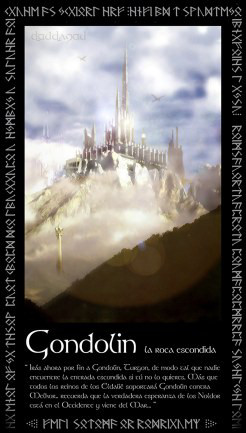
While most people could easily create a case for Eöl being the cause of Maeglin’s problems, Shippey (1992) made an interesting suggestion about Aredhel having a significant effect on Maeglin’s life:
“one could simply put the blame on Aredhel. She left Gondolin pridefully, against advice, and turned away from her wiser brothers to her more evil attraction of Fëanorian fieriness.” (Shippey, The Road to Middle-earth, Visions and Revisions)
After Aredhel and Eöl’s deaths, Maeglin stayed in Gondolin, and became great among the Gondolindrim. He rose high in the favour of Turgon, and made steel from the iron in the Echoriath, designing stronger and keener weapons for the city.
“for if he would learn eagerly and swiftly all that he might, he had much also to teach.
…
Wise in counsel was Maeglin and wary, and yet hardy and valiant at need.” (Silmarillion, Of Maeglin)
But the Doom of the Noldor was still in place, and Maeglin’s life had hidden anguish.
“From his first days in Gondolin he [Maeglin] had borne a grief, ever worsening, that robbed him of all joy; he loved the beauty of Idril and desired her, without hope. The Eldar wedded not with kin so near, nor ever before had any desired to do so. And however that might be, Idril loved Maeglin not at all; and knowing his thought of her she loved him the less. For it seemed to her a thing strange and crooked in him, as indeed the Eldar ever since have deemed it; an evil fruit of the Kinslaying, whereby the shadow of the curse of Mandos fell upon the last hope of the Noldor. But as the years passed still Maeglin watched Idril, and waited, and his love turned to darkness in his heart. And he sought the more to have his will in other matters, shirking no toil or burden, if he might thereby have power.
Thus it was in Gondolin; and amid all the bliss of that realm, while its glory lasted, a dark seed of evil was sown.”
Gondolin became very much a Hidden City. There was little traffic in and out of the realm, and the Gondolindrim interfered little in the affairs of Beleriand. Even through the Siege of Angband, Turgon and his people remained shut away in Gondolin.
The first people he welcomed into his kingdom after the hostilities were Húrin and Huor. Turgon came to look upon the sons of Galdor with love, and wanted to keep them with him in Gondolin. However, after a year, he let them leave on their promise not to divulge the Hidden City’s secrets. And this promise they kept, though Galdor and many others guessed at where they had been for the last year. Eventually rumours of a Hidden City spread to the ears of Morgoth.
At the end of the Siege, Turgon would not suffer any of his people to leave the city for war, but he did finally try to help the rest of the Noldor by sending secret companies of the Gondolindrim to the Mouths of Sirion and to the Isle of Balar. There they built ships, and set out for the West to ask forgiveness and aid from the Valar. But none of the ships ever reached Valinor, and only few returned from their adventures.
The Houses of the Gondolindrim
The “Book of Lost Tales 2” contains a description of the 11 Houses of the Gondolindrim, known only in canon through Glorfindel of the House of the Golden Flower and Galdor of the Tree. The different Houses were:
– House of the Fountain Silver and diamonds were their delight, and their swords were long, bright and pale. They went into battle to the music of flutes. Their leader was Ecthelion, who had the fairest voice and was most skilled in music of all the Gondolindrim.
– House of the Golden Flower This House bore a rayed sun on their shields. Their lord was Glorfindel, who bore a mantle rich with threads of gold.
– House of the Hammer of Wrath From this House came many of the best smiths and craftsmen, and they revered Aulë above all the other Valar. In the early days, many of them had been recruited from those Noldor who escaped from Morgoth’s mines, and the hate of the House for all his works and creatures was great. Their sign was the Stricken Anvil, and a hammer that “smiteth sparks about it” was set on their shields. Red gold and black iron was their delight. They fought with great maces, and their shields were heavy. Their leader was Rog, second only in valour to Galdor.
– House of the Harp A harp of silver was blazoned on a field of black on their armour. Their heavy and squat leader Salgant was craven, and fawned upon Maeglin. He alone wore a harp of gold on his armour.
– House of the Heavenly Arch A large folk of uncounted wealth, which was reflected in their dress and weaponry. They were arrayed in a glory of colours, and their arms were set with jewels that flamed in the sun. Their shields were coloured as the blue of heaven, with the bosses a jewel built of seven gems – rubies, amethysts, sapphires, emeralds, chrysophase, topaz and amber. Opals of huge size were set in their helms. Their chief was Eglamoth, and he wore a blue mantle on which stars were embroidered in crystal. He was the only one of the Noldor to bear a bent sword, but he preferred the bow, and his House were known as archers.
– House of the King / King’s House Their colours were white, gold and red, and their emblems were the moon, the sun and the scarlet heart (representing the heart of Fingon torn out by Orcs at the Nirnaeth).
– House of the Mole Their round caps of steel were covered with moleskin, they wore black armour with no emblem, and they fought with two-headed axes. They were led by Maeglin.
– House of the Pillar Marshalled by Penlod, tallest of the Noldor, along with the House of the Tower of Snow.
– House of the Swallow – This House bore a fan of feathers on their helm, and were arrayed in white, dark blue, purple and black. They showed an arrowhead on their shields, and were known as archers. Their lord was Duilin.
– House of the Tower of Snow Marshalled by Penlod, tallest of the Noldor, along with the House of the Pillar.
– House of the Tree A great House who wore raiment of green. They fought with iron-studded club or with slings. Their lord Galdor was held to be the most valiant of the Gondolindrim save Turgon alone. He survived the downfall of Gondolin, and it is possible that he lived in the Falas until the Third Age, as an elf called Galdor of the Havens was present at the Council of Elrond.
Along with the 11 main Houses, the bodyguard of Tuor was accounted a twelfth House.
– House of the Wing (Tuor’s men) Tuor’s bodyguard wore wings like swans or gulls on their head, and the emblem of the White Wing was on their shield.
The first meeting between Elves and Men
During the days of the Long Peace, Finrod went alone into Ossiriand, after tiring of a hunt with Maedhros and Maglor. There, in the foothills of the Ered Lindon, he saw lights and heard the sound of song and when he went to investigate, he came across some Bëor’s men.
“Long Felagund watched them, and love for them stirred in his heart; but he remained hidden in the trees until they had all fallen asleep. Then he went among the sleeping people, and say beside their dying fire where none kept watch; and he took up a rude harp which Bëor had laid aside, and he played music upon it such as the ears of Men had not heard.” (Silmarillion, Of the Coming of Men into the West)
Finrod then dwelt among them for a time, and they came to love him. They took him for their lord, and were ever after loyal to the house of Finarfin.
For the history of Bëor, and the First House of the Edain, see here.








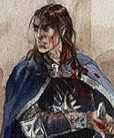

1 Comment
I find this article really intriguing and thorough, I especially liked the break down of the different houses in Gondolin.